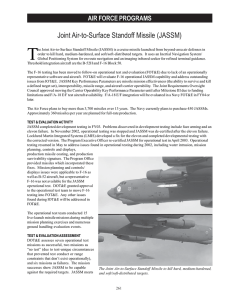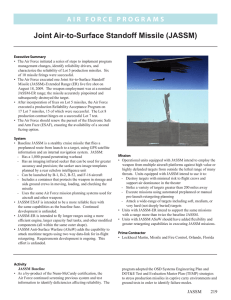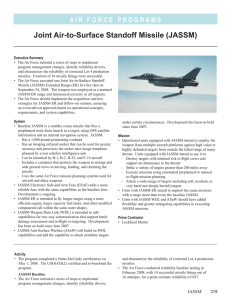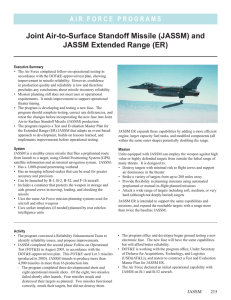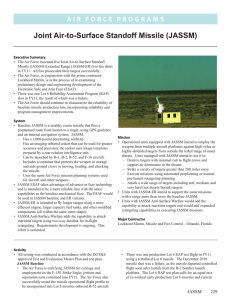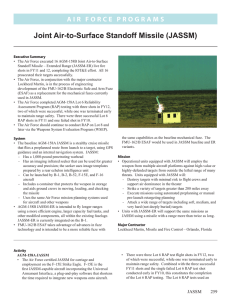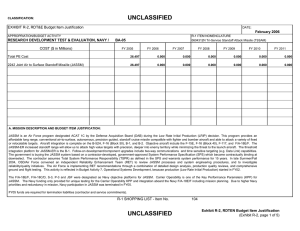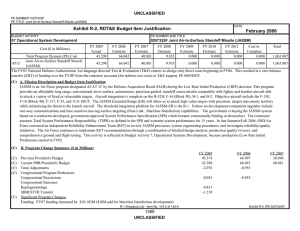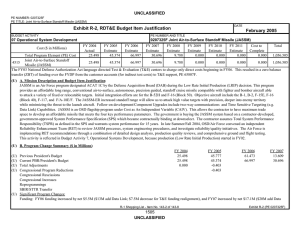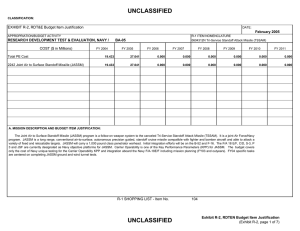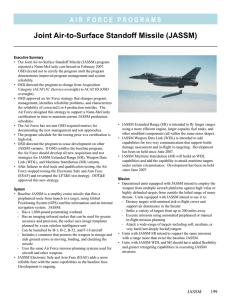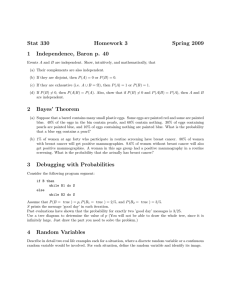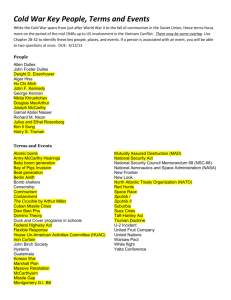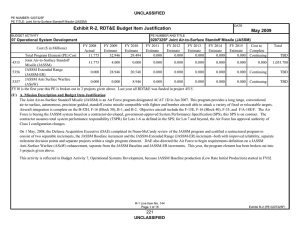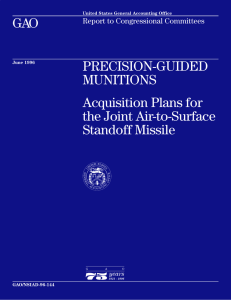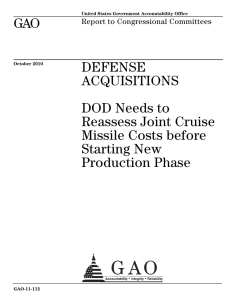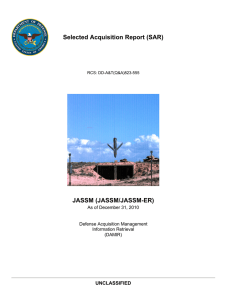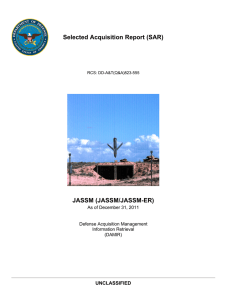Joint Air-to-Surface Standoff Missile (JASSM) AIR FORCE PROGRAMS
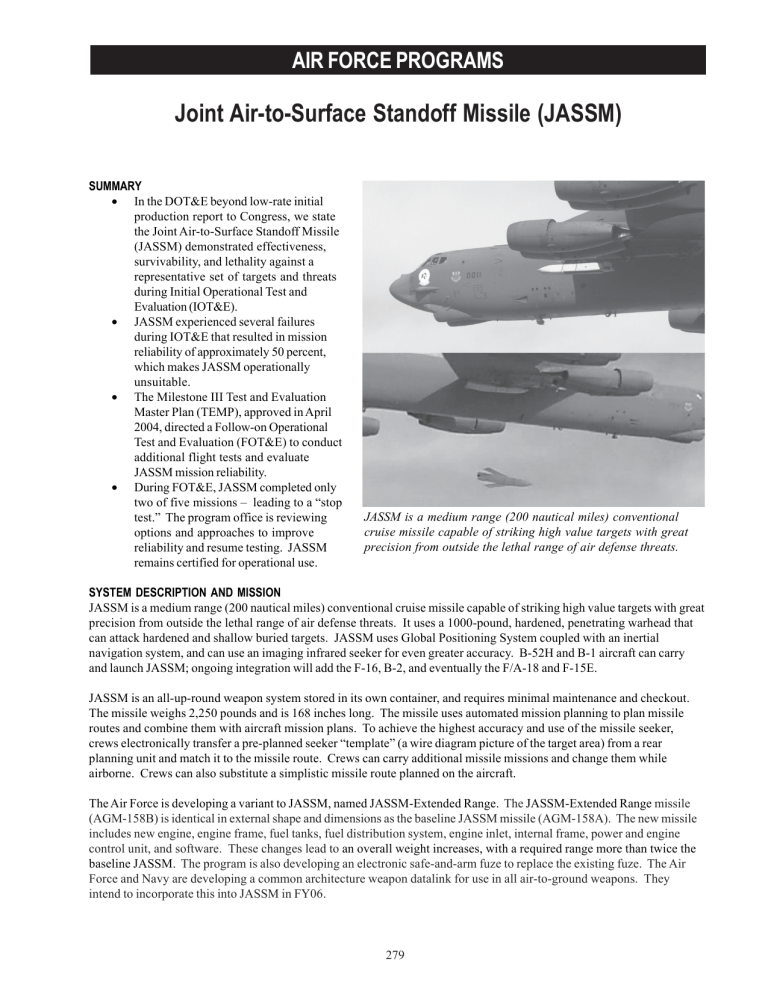
AIR FORCE PROGRAMS
Joint Air-to-Surface Standoff Missile (JASSM)
SUMMARY
• In the DOT&E beyond low-rate initial production report to Congress, we state the Joint Air-to-Surface Standoff Missile
(JASSM) demonstrated effectiveness, survivability, and lethality against a representative set of targets and threats during Initial Operational Test and
Evaluation (IOT&E).
• JASSM experienced several failures during IOT&E that resulted in mission reliability of approximately 50 percent, which makes JASSM operationally unsuitable.
• The Milestone III Test and Evaluation
Master Plan (TEMP), approved in April
2004, directed a Follow-on Operational
Test and Evaluation (FOT&E) to conduct additional flight tests and evaluate
JASSM mission reliability.
• During FOT&E, JASSM completed only two of five missions – leading to a “stop test.” The program office is reviewing options and approaches to improve reliability and resume testing. JASSM remains certified for operational use.
JASSM is a medium range (200 nautical miles) conventional cruise missile capable of striking high value targets with great precision from outside the lethal range of air defense threats.
SYSTEM DESCRIPTION AND MISSION
JASSM is a medium range (200 nautical miles) conventional cruise missile capable of striking high value targets with great precision from outside the lethal range of air defense threats. It uses a 1000-pound, hardened, penetrating warhead that can attack hardened and shallow buried targets. JASSM uses Global Positioning System coupled with an inertial navigation system, and can use an imaging infrared seeker for even greater accuracy. B-52H and B-1 aircraft can carry and launch JASSM; ongoing integration will add the F-16, B-2, and eventually the F/A-18 and F-15E.
JASSM is an all-up-round weapon system stored in its own container, and requires minimal maintenance and checkout.
The missile weighs 2,250 pounds and is 168 inches long. The missile uses automated mission planning to plan missile routes and combine them with aircraft mission plans. To achieve the highest accuracy and use of the missile seeker, crews electronically transfer a pre-planned seeker “template” (a wire diagram picture of the target area) from a rear planning unit and match it to the missile route. Crews can carry additional missile missions and change them while airborne. Crews can also substitute a simplistic missile route planned on the aircraft.
The Air Force is developing a variant to JASSM, named JASSM-Extended Range. The JASSM-Extended Range missile
(AGM-158B) is identical in external shape and dimensions as the baseline JASSM missile (AGM-158A). The new missile includes new engine, engine frame, fuel tanks, fuel distribution system, engine inlet, internal frame, power and engine control unit, and software. These changes lead to an overall weight increases, with a required range more than twice the baseline JASSM.
The program is also developing an electronic safe-and-arm fuze to replace the existing fuze. The Air
Force and Navy are developing a common architecture weapon datalink for use in all air-to-ground weapons. They intend to incorporate this into JASSM in FY06.
279
TEST AND EVALUATION ACTIVITY
AIR FORCE PROGRAMS
The Air Force completed operational testing in October 2003. The Air Force conducted additional evaluation of missile performance into February 2004. The Air Force reported JASSM as effective and potentially suitable, with a mission reliability of about 55 percent. The program completed two additional development missions, one a failure (October 2003) and one a success (March 2004). DOT&E completed the beyond low-rate production report in April, rating JASSM as effective but not suitable, with a mission reliability of 53 percent.
DOT&E approved the Milestone III Test and Evaluation Master Plan in February, with the following stipulations:
• Conduct FOT&E to evaluate reliability and address unanswered issues found during IOT&E.
• Return to the Office of the Secretary of Defense (OSD) with detailed test strategies for JASSM-Extended Range, a new electronic fuze, and JASSM datalink.
The program completed five missions in follow-on testing, with only two successes. The first mission was a B-1 operational test mission against a soft target (a success). The second was a B-2 mission planned in the Gulf of Mexico.
This mission failed when the crew could not correctly load a re-planned mission into the missile during flight. A mission planning software error caused this failure. The third mission was a success, launching JASSM from a B-1 against a soft ground target. The fourth mission, launched from an F-16, failed to reach engine start due to a generator problem. The fifth mission, also a failure, went out of control in the target area after a B-2 launch. Analysis shows the fuze electronically shorted out the control system on the missile. After this last failure, the Air Force Operational Test and
Evaluation Center stopped all operational flight tests.
TEST AND EVALUATION ASSESSMENT
Operational testing showed that JASSM could destroy planned targets with great accuracy and precision, including soft targets, medium hardened bunkers, and earth-mounded very hard bunkers. In many cases, JASSM destroyed the target with a single missile. JASSM performed better than predicted against its hardest target, needing less missiles than predicted to achieve a kill. JASSM exceeded range requirements, and proved sufficiently robust to handle Global
Positioning System jamming, target camouflage, and a range of environmental conditions without degrading capability.
Three fuze failures occurred during operational testing. Failure analysis determined that fuze production quality problems caused two failures. It could not positively identify the cause of the third failure.
Mission planning is a concern. The user requirement is to complete a JASSM mission in 10 minutes (average).
Operational testing (B-52) completed 144 missile missions for eleven aircraft sorties in 16 minutes (average). B-1 JASSM integration testing completed 48 missile missions for two aircraft sorties, with times ranging from 15 to 25 minutes
(average). B-1 testing could complete only 24 missions at a time.
FOT&E began in April 2004, but stopped in August after consecutive failures. Mission reliability, expected to progress as improvements were implemented into production missiles, has instead declined to 50 percent. Follow-on testing included the evaluation of F-16 integration and development, B-1 integration and operational testing, and B-2 development missions.
The program is designing a new strategy to improve reliability, including additional developmental testing, correction of deficiencies in missiles delivered to the field, and additional operational testing to demonstrate improving reliability. At
OSD direction, the program is undergoing a reliability enhancement review, with results expected in November. The program is considering options to address mission reliability and provide a path that can verify system capability before we will approve resumption of FOT&E.
The program will return to OSD with a TEMP and test plan for JASSM-Extended Range, the new fuze, and the datalink.
We expect this test planning effort to follow the re-design of FOT&E.
280
